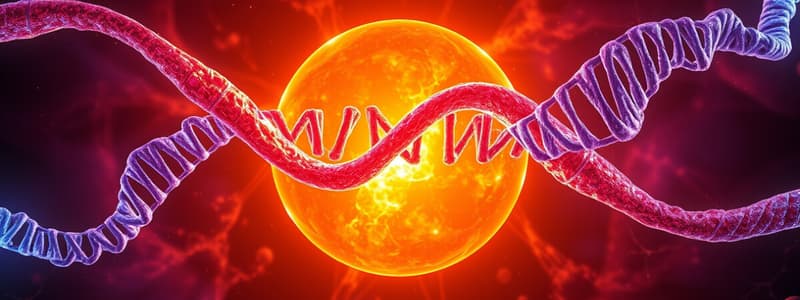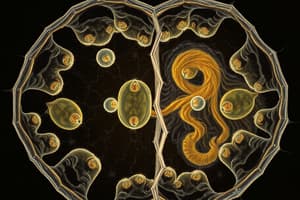Podcast
Questions and Answers
What process is responsible for the division of the nucleus in eukaryotic cells?
What process is responsible for the division of the nucleus in eukaryotic cells?
- Meiosis
- Fission
- Mitosis (correct)
- Cytokinesis
What are the identical copies of a chromosome called after DNA replication?
What are the identical copies of a chromosome called after DNA replication?
- Centromeres
- Chromatin
- Homologs
- Sister chromatids (correct)
During which phase of the cell cycle does DNA condense into chromosomes?
During which phase of the cell cycle does DNA condense into chromosomes?
- Interphase
- Telophase
- Prophase (correct)
- Metaphase
How many chromosomes do human cells typically contain?
How many chromosomes do human cells typically contain?
What is the role of chromosomes during cell division?
What is the role of chromosomes during cell division?
What do genes on chromosomes encode?
What do genes on chromosomes encode?
What is chromatin?
What is chromatin?
In which structure do sister chromatids remain attached?
In which structure do sister chromatids remain attached?
How many sets of chromosomes does a typical human cell inherit from each parent?
How many sets of chromosomes does a typical human cell inherit from each parent?
What occurs prior to mitosis in a cell?
What occurs prior to mitosis in a cell?
Every cell in your body has different DNA.
Every cell in your body has different DNA.
Chromosomes are primarily composed of RNA and proteins.
Chromosomes are primarily composed of RNA and proteins.
The abbreviation for the process of nucleus division is called meiosis.
The abbreviation for the process of nucleus division is called meiosis.
Sister chromatids are two identical copies of a chromosome.
Sister chromatids are two identical copies of a chromosome.
A single human chromosome can have hundreds or thousands of genes.
A single human chromosome can have hundreds or thousands of genes.
The region where sister chromatids are attached is known as the centromere.
The region where sister chromatids are attached is known as the centromere.
During cell division, DNA is always found in its coiled structure as chromosomes.
During cell division, DNA is always found in its coiled structure as chromosomes.
Humans have a total of 46 chromosomes divided into two sets.
Humans have a total of 46 chromosomes divided into two sets.
Mitosis occurs after DNA replication has taken place.
Mitosis occurs after DNA replication has taken place.
Chromosomes are formed during the interphase of the cell cycle.
Chromosomes are formed during the interphase of the cell cycle.
Match the following terms with their definitions:
Match the following terms with their definitions:
Match the following processes with their descriptions:
Match the following processes with their descriptions:
Match the following components with their characteristics:
Match the following components with their characteristics:
Match the following cell cycle phases with their functions:
Match the following cell cycle phases with their functions:
Match the following terms related to DNA with their descriptions:
Match the following terms related to DNA with their descriptions:
Match the following facts about human chromosomes with their details:
Match the following facts about human chromosomes with their details:
Match the following phases with their sequence in the cell cycle:
Match the following phases with their sequence in the cell cycle:
Match the following DNA structures with their properties:
Match the following DNA structures with their properties:
Match the following genetic concepts with their summaries:
Match the following genetic concepts with their summaries:
Match the following statements about DNA and chromosomes:
Match the following statements about DNA and chromosomes:
Study Notes
DNA Consistency in Cells
- Every cell in the body contains the same DNA, ensuring uniform genetic material across different cell types.
- Chromosomes form prior to cell division to guarantee that daughter cells receive a complete set of genetic material.
Process of Cell Division
- Mitosis is the process where the nucleus divides before the entire cell division.
- Prior to mitosis, DNA is replicated, creating two copies for each daughter cell.
- Effective sorting and separation of chromosomes during cell division ensures that each daughter cell receives identical genetic information.
Structure of Chromosomes
- Chromosomes are coiled structures composed of DNA and proteins, facilitating proper segregation during cell division.
- In non-dividing phases, DNA exists as chromatin, a less condensed and grainy form.
Chromatid and Centromere
- After DNA replication, each chromosome appears as an "X," consisting of two identical sister chromatids connected at the centromere.
- Sister chromatids ensure that each resulting cell inherits the same genetic information.
DNA and Genes
- Chromosomes encode genetic instructions for protein synthesis, organized into units called genes.
- Each gene typically provides instructions for a single protein, with many genes present on each chromosome.
Human Chromosome Structure
- Human cells typically contain two sets of chromosomes: one inherited from each parent.
- Each set has 23 chromosomes, totaling 46 chromosomes per cell, organized into 23 pairs.
- Homologous chromosomes in pairs share size, shape, and genetic content but contain different alleles (variant forms of the same gene).
DNA Consistency in Cells
- Every cell in the body contains the same DNA, ensuring uniform genetic material across different cell types.
- Chromosomes form prior to cell division to guarantee that daughter cells receive a complete set of genetic material.
Process of Cell Division
- Mitosis is the process where the nucleus divides before the entire cell division.
- Prior to mitosis, DNA is replicated, creating two copies for each daughter cell.
- Effective sorting and separation of chromosomes during cell division ensures that each daughter cell receives identical genetic information.
Structure of Chromosomes
- Chromosomes are coiled structures composed of DNA and proteins, facilitating proper segregation during cell division.
- In non-dividing phases, DNA exists as chromatin, a less condensed and grainy form.
Chromatid and Centromere
- After DNA replication, each chromosome appears as an "X," consisting of two identical sister chromatids connected at the centromere.
- Sister chromatids ensure that each resulting cell inherits the same genetic information.
DNA and Genes
- Chromosomes encode genetic instructions for protein synthesis, organized into units called genes.
- Each gene typically provides instructions for a single protein, with many genes present on each chromosome.
Human Chromosome Structure
- Human cells typically contain two sets of chromosomes: one inherited from each parent.
- Each set has 23 chromosomes, totaling 46 chromosomes per cell, organized into 23 pairs.
- Homologous chromosomes in pairs share size, shape, and genetic content but contain different alleles (variant forms of the same gene).
DNA Consistency in Cells
- Every cell in the body contains the same DNA, ensuring uniform genetic material across different cell types.
- Chromosomes form prior to cell division to guarantee that daughter cells receive a complete set of genetic material.
Process of Cell Division
- Mitosis is the process where the nucleus divides before the entire cell division.
- Prior to mitosis, DNA is replicated, creating two copies for each daughter cell.
- Effective sorting and separation of chromosomes during cell division ensures that each daughter cell receives identical genetic information.
Structure of Chromosomes
- Chromosomes are coiled structures composed of DNA and proteins, facilitating proper segregation during cell division.
- In non-dividing phases, DNA exists as chromatin, a less condensed and grainy form.
Chromatid and Centromere
- After DNA replication, each chromosome appears as an "X," consisting of two identical sister chromatids connected at the centromere.
- Sister chromatids ensure that each resulting cell inherits the same genetic information.
DNA and Genes
- Chromosomes encode genetic instructions for protein synthesis, organized into units called genes.
- Each gene typically provides instructions for a single protein, with many genes present on each chromosome.
Human Chromosome Structure
- Human cells typically contain two sets of chromosomes: one inherited from each parent.
- Each set has 23 chromosomes, totaling 46 chromosomes per cell, organized into 23 pairs.
- Homologous chromosomes in pairs share size, shape, and genetic content but contain different alleles (variant forms of the same gene).
Studying That Suits You
Use AI to generate personalized quizzes and flashcards to suit your learning preferences.
Description
This quiz explores the critical processes of mitosis and DNA replication in eukaryotic cells. Test your understanding of how chromosomes ensure that each daughter cell receives identical genetic material. Dive into the mechanisms that guarantee cellular consistency across your body.




